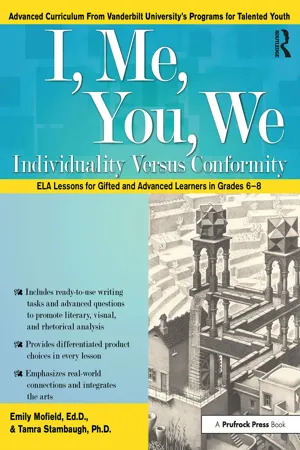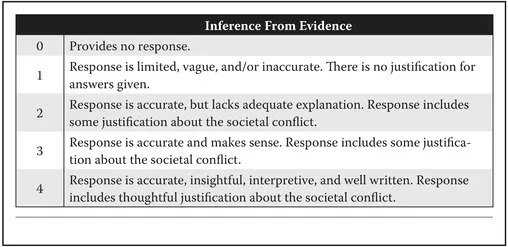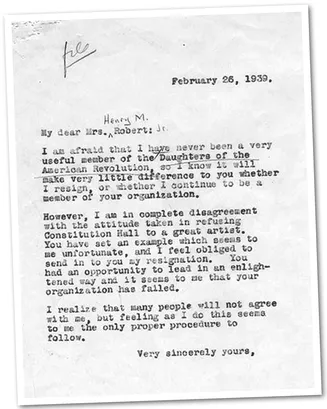
I, Me, You, We
Individuality Versus Conformity, ELA Lessons for Gifted and Advanced Learners in Grades 6-8
- 226 pages
- English
- ePUB (mobile friendly)
- Available on iOS & Android
I, Me, You, We
Individuality Versus Conformity, ELA Lessons for Gifted and Advanced Learners in Grades 6-8
About This Book
Winner of the 2016 NAGC Curriculum Studies Award
In I, Me, You, We: Individuality Versus Conformity, students explore essential questions such as "How does our environment shape our identity? What are the consequences of conforming to a group? When does social conformity go too far?" This unit, developed by Vanderbilt University's Programs for Talented Youth and aligned to the Common Core State Standards (CCSS), includes a major emphasis on rigorous evidence-based discourse through the study of common themes across rich, challenging nonfiction and fictional texts.
The unit guides students to examine the fine line of individuality versus conformity through the related concepts of belongingness, community, civil disobedience, questioning the status quo, and self-reliance by engaging in creative activities, Socratic seminars, literary analyses, and debates. Lessons include close-readings with text-dependent questions, choice-based differentiated products, rubrics, formative assessments, and ELA tasks that require students to analyze texts for rhetorical features, literary elements, and themes through argument, explanatory, and prose-constructed writing.
Ideal for pre-AP and honors courses, the unit features short stories from Kurt Vonnegut and Ray Bradbury, poetry from Emily Dickinson and Maya Angelou, art by M. C. Escher and Pablo Picasso, and primary source documents from Plato, Eleanor D. Roosevelt, William Bradford, Ralph Waldo Emerson, and Henry David Thoreau.
Grades 6-8
Frequently asked questions
Information
AN EXAMINATION OF RISK
Lesson 4
"Letter to DAR" and "My Day" Column
Goals/Objectives
- ∎ explain with evidence how a writer supports a claim,
- ∎ respond to interpretations of texts through a variety of contexts by justifying ideas and providing new information, and
- ∎ compare and contrast texts and real-world events on theme.
- ∎ reason through an issue by analyzing points of view, assumptions, and implications;
- ∎ use evidence to develop and support inferences;
- ∎ evaluate the use of effective argumentation; and
- ∎ analyze societal or individual conflicts resulting from the struggle between individuality versus conformity.
- ∎ support conformity versus individuality generalizations with evidence,
- ∎ develop and apply generalizations of additional key concepts, and
- ∎ explain the conflict between conformity and individuality.
Accelerated CCSS ELA Standards
- ∎ RI.9-10.1
- ∎ RI.9-10.2
- ∎ RI.9-10.3
- ∎ RI.9-10.6
- ∎ RI.9-10.7
- ∎ RI.9-10.9
- ∎ SL.9-10.1
- ∎ SL.9-10.1c
- ∎ SL.9-10.1d
- ∎ RH.9-10,1
- ∎ RH.9-10.2
- ∎ RH.9-10.8
- ∎ RH.9-10.9
- ∎ W.9-10.4
Materials
- ∎ Handout 1.3: Concept Organizer (continued from previous lessons)
- ∎ Handout 4.1: "Letter to DAR" by Eleanor Roosevelt and "Response From ∎ Mrs. Robert, President of DAR"
- ∎ Handout 4.2: "My Day" Newspaper Column by Eleanor Roosevelt
- ∎ Handout 4.3: Reasoning About a Situation or Event
- ∎ Rubric 1: Product Rubric (Appendix C)
Introductory Activity
Read Text
Text-Dependent Questions
- ∎ What is the cause of the controversy?
- ∎ What do these documents reveal about Eleanor Roosevelt's character?
- ∎ What questions do you have about the context of these documents?
- ∎ What role does Eleanor Roosevelt's emotion play in the resignation letter? ∎ Consider her appeal to guilt and personal obligation.
Read Text
Text-Dependent Questions
- ∎ What additional insight do you have about Eleanor Roosevelt's decision making?
- ∎ What phrase in the document best supports her fight against the status quo?
- ∎ What does this document reveal about her character? Support this with textual evidence.
- ∎ What one word best describes Eleanor Roosevelt, based on this text? What evidence supports this?
In-Class Activity to Deepen Learning
- ∎ Situation: Should Eleanor Roosevelt resign from the DAR?
- ∎ Stakeholders: Eleanor Roosevelt, Marian Anderson, DAR Representatives, FDR.
- ∎ Point of View: How the stakeholder(s) would answer the question, including evidence of why they feel this way.
- ∎ Assumptions: The values and beliefs taken for granted by the stakeholders.
- ∎ Implications: The short- and long-term consequences that happened or could have happened if that particular point of view were actualized.

Concept Connections
Choice-Based Differentiated Products

- ∎ Read three additional "My Day" columns written by Eleanor Roosevelt. Create a product (PowerPoint, video documentary, brochure, pamphlet, monologue) that shows how Eleanor Roosevelt's individuality fought against the status quo during her time period. Also explain how her decision-making had long-term implications to today. Cite textual evidence from all three sources in your product.
- ∎ Study the style of Eleanor Roosevelt's "My Day" columns. Develop your own "My Day" column that addresses contemporary national issues using the same style Eleanor Roosevelt used. Be sure to include an idea relating to an individual questioning the status quo.
- ∎ Find various quotes of Eleanor Roosevelt that reflect her passion to promote positive change in society. Develop a collage with quotes, images, pictures, and symbols that represent Eleanor Roosevelt as a nonconformist who promoted change in society. Include at least 10 quotes from her texts, letters, or speeches.
ELA Practice Tasks
- ∎ Read three "My Day" columns (suggested source: http://www.gwu.edu/~erpapers/myday/browsebyyear.cfm) and explain the extent to which Eleanor Roosevelt was a nonconformist who promoted change during her lifetime. Use sufficient evidence from the texts to develop your reasoning in an explanatory essay and support your central idea.
- ∎ Research more about the controversy around Marian Anderson singing at the Lincoln Memorial Dedication. Explain the causes of the controversy and explain the short- and long-term implications (effects). Use sufficient evidence from primary and secondary sources and cite your sources appropriately.

Formative Assessment
- Ask students to respond to the following prompt in a single paragraph: What can you infer is meant by the phrase "you had an opportunity to lead in an enlightened way" and how does it relate to the societal conflict?
- Use the scoring guidelines in Figure 4.3 to evaluate students' assessments.
Handout 4.1
"Letter to DAR" by Eleanor Roosevelt and "Response From Mrs. Robert, President of DAR"

"Letter to DAR" by Eleanor Roosevelt February 26, 1939
Table of contents
- Cover
- Half Title
- Title Page
- Copyright Page
- Table of Contents
- Dedication
- Acknowledgements
- Introduction
- Pretest
- Pretest Rubric
- AN EXAMINATION OF IDENTITY: How Does Our Environment Shape Our Identity?
- AN EXAMINATION OF RISK: Against the Status Quo
- AN EXAMINATION OF SOCIAL CONFORMITY
- AN EXAMINATION OF NONCONFORMITY: A Force of Social Change
- References
- Appendix A: Instructions for Using the Models
- Appendix B: Blank Models and Guides
- Appendix C: Rubrics
- About the Authors
- Common Core State Standards Alignment